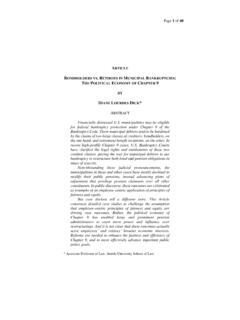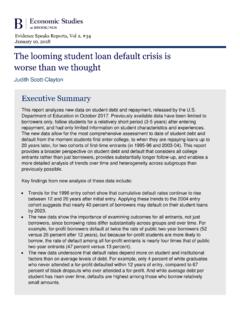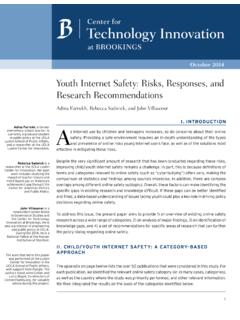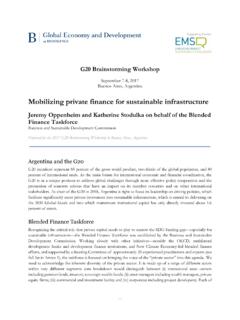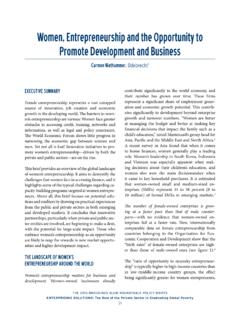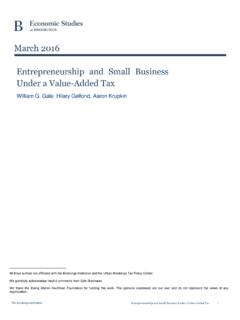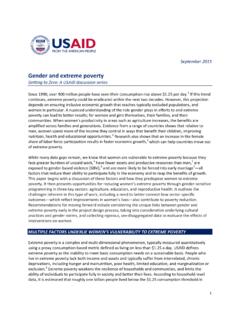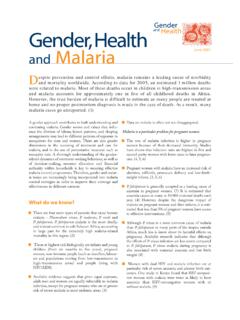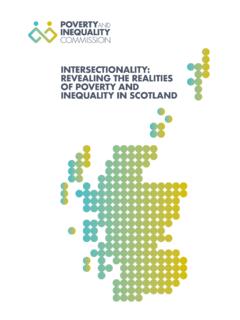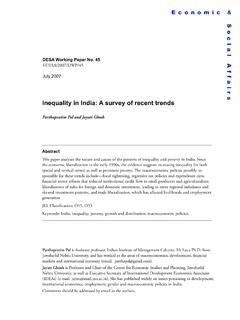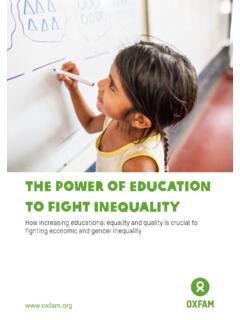Transcription of TODAY S CHALLENGES FOR GIRLS EDUCATION
1 GLOBAL ECONOMY & DEVELOPMENT WORKING PAPER 90 | JUNE 2015 TODAY S CHALLENGES FOR GIRLS EDUCATIONE lizabeth M. King and Rebecca WinthropElizabeth King is a nonresident senior fellow in the Center for Universal EDUCATION at the Brookings Winthrop is a senior fellow and director of the Center for Universal EDUCATION at the Brookings : Bridget A. McElroy was an integral part of preparing this paper. Her research assistance and project management skills were crucial in helping us develop this paper in the short time frame available.
2 We are deeply thankful for her partnership and hard work. We are grateful for the many people who provided advice, guidance, feedback, critique, and importantly shared reports and data with us. We are indebted to the numerous individuals in over 25 organizations that provided verbal and written feedback during the consultation process conducted during the drafting of this paper. In addition there are several individuals with whom we worked especially closely on the drafting of this paper and to whom we owe our deepest thanks.
3 First and foremost is Nora Fyles and the col-laboration with the GIRLS EDUCATION Initiative which was crucial in developing this paper. We also would like to acknowledge the essential contributions of Judith-Ann Walker, Lucy Lake, Pauline Rose, and Urvashi Sahni. Finally, we would like to thank the government of Norway and the Special Envoy for Global EDUCATION Gordon Brown for their interest in these recommendations, especially regarding the Oslo Summit on EDUCATION for Development.
4 This paper was supported by the William and Flora Hewlett Foundation. Brookings recognizes that the value it provides is in its absolute commitment to quality, independence, and impact. Activities supported by its donors reflect this commitment and the analysis and recommendations are not determined or influenced by any dona-tion. The authors disclose that the government of Norway is a funder to the Brookings GLOBAL ECONOMY AND DEVELOPMENT PROGRAMCONTENTSE xecutive Summary ..viWhy we care: Seven main benefits of GIRLS EDUCATION to society.
5 ViiProgress can we build on ..viiiWhat we face TODAY : GIRLS EDUCATION hotspots ..ixWhy GIRLS are behind: What we know about gender equality in EDUCATION ..xWhat is working: Evidence on addressing GIRLS EDUCATION ..xiWhat should we do: Taking action on GIRLS EDUCATION ..xvI. Why we care: Seven main benefits of GIRLS EDUCATION to society ..1II. Progress we can build on ..5 Building on aggregate EDUCATION expansion around the world ..5 Building on civil society and political momentum ..5 III. What we face TODAY : GIRLS EDUCATION hotspots.
6 9 Assessing gender equality: gender gaps in the quantity and quality of EDUCATION ..9 The largest gender gaps in enrollment are in the poorest countries ..10 Countries in Africa, Middle East, and South Asia are home to the widest gender gaps in enrollment ..10 The GIRLS who face multiple disadvantages are farthest behind ..13 Overall learning levels are low, but GIRLS do worse in math and boys in reading ..16 Soft skills also key for GIRLS ..18 Emerging hotspots: Bogs, traps, and ceilings in GIRLS EDUCATION .
7 19 Stuck in an EDUCATION bog ..20 Caught in an EDUCATION quality trap ..22 Bumping against a gender glass ceiling ..23 Why GIRLS are behind: What we know about gender equality in EDUCATION ..24 Understanding the roots of EDUCATION gender gaps ..24 Schooling is more costly for GIRLS ..24 Restricted space and expectations limit GIRLS ability to reap the returns to EDUCATION ..26 Early marriage and teen pregnancy keep GIRLS out of school ..28 Pervasive school-related violence harms millions of GIRLS and young women.
8 32 Lifting the obstacles to GIRLS EDUCATION ..34 What is working: Evidence on addressing GIRLS EDUCATION ..35 High-quality and gender -sensitive curricula and learning materials ..35 TODAY S CHALLENGES FOR GIRLS EDUCATION vGirl-friendly infrastructure ..37 Great teachers ..38 Cost-reducing mechanisms ..42 Safety in schools and freedom from violence ..45 GIRLS and women s capabilities for leadership and ability to make choices.
9 45 What should we do: Taking action on GIRLS EDUCATION ..50 Recommendation 1: Lean-in with GIRLS and women s leadership ..50 Recommendation : Build strong girl leaders ..51 Recommendation : Girl-generated data ..52 Recommendation 2: Focus systemic reform with a gender lens ..54 Recommendation : Design for EDUCATION hotspots ..55 Recommendation : Focus with a gender lens ..55 LIST OF TABLEST able 1. EDUCATION and gender indicators: Bogs, traps and ceilings ..xiiTable 2. gender gaps in net enrollment rates in primary and secondary EDUCATION .
10 11 Table 3. gender gaps in net enrollment in primary and secondary EDUCATION ..12 Table 4. Percentage of children aged 7-14 who are working ..26 Table 5. Labor force participation rates, by sex and age group, by world region latest year ..29 Table 6. Percent share of female teachers in secondary EDUCATION ..41 Appendix Table 1. Female-Male ratio of standardized achievement tests, by competency level; International and regional tests, latest years ..73 LIST OF FIGURESF igure 1. Trend in average years of schooling, 1950-2010.
